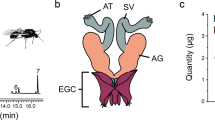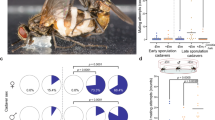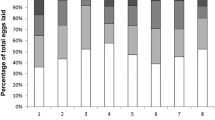Abstract
Males of the tropical ant Cardiocondyla obscurior are either wingless and aggressive or winged and docile, and both compete for access to virgin queens in the nest1,2. Although the fighter males (ergatoids) attack and kill other ergatoids, they tolerate and even attempt to mate with their winged rivals. Here we show that the winged males avoid the aggression of wingless males by mimicking the chemical bouquet of virgin queens, but that their mating success is not reduced as a result. This example of female mimicry by vigorous males is surprising, as in other species it is typically used as a protective strategy by weaker males, and may explain the coexistence and equal mating success of two male morphs.
Similar content being viewed by others
Main
Ants typically mate during short nuptial flights that give little opportunity for male–male combat3. By contrast, sexual individuals of C. obscurior mate inside their natal nests. Intensive intrasexual competition has led to the evolution of sabre-shaped mandibles and escalated fighting to the death among locally mating ergatoid males1,2. Winged males, on the other hand, have weak mandibles, behave peacefully and leave the nest one to two weeks after emergence in order to mate outside. But, surprisingly, before dispersal they are as successful as ergatoid males in attaining copulations with virgin nestmate queens (U-test: U = 903.0, P = 0.86, nergatoid = 33 observations for 24 min each, nwinged = 56). Ergatoid males would therefore be expected to benefit from killing their winged rivals4.
Contrary to the aggression that might be expected towards winged males, ergatoid males typically restrict their fighting to other ergatoids, and attempt to mate with the winged males1. Our behavioural observations indicate that young winged males (1–5 days old) are as attractive as young virgin queens to ergatoid males (ergatoid males mounted 11 out of 12 winged males and 15 out of 17 virgin queens; 72–120 min observation per individual; Fisher's exact test: d.f. = 1, P = 1.0). By contrast, ergatoid males showed no interest in older winged males (6–10 days, n = 17; old–young: P < 0.001), whereas virgin queens remained attractive regardless of their age (old: 12 out of 14; old–young: P = 1.0).
This toleration of winged males and attempts at homosexual mating with them can be explained by the chemical resemblance of winged males and virgin queens in their bouquet of cuticular hydrocarbons on the body surface, which are important for communication in social insects5,6,7,8. In a discriminant analysis of hydrocarbon profiles obtained by gas chromatography with mass spectrometry9, 1-day-old winged males and virgin queens formed a single cluster that was distinct from those of ergatoid males and workers (Fig. 1a). However, for 10-day-old ants, all four groups were clearly separated (Fig. 1b). We conclude that the odour similarity of young — and only young — winged males to virgin queens explains their age-dependent attractiveness to ergatoid males.
Hydrocarbons were extracted from workers (day 1: n1 = 10, day 10: n10 = 10; circles), ergatoid males (n1 = 13, n10 = 12; squares), winged males (n1 = 14, n10 = 8; diamonds) and virgin queens (n1 = 13, n10 = 7; triangles) by gas chromatography with mass spectrometry, and were statistically analysed by principal-components analysis followed by stepwise discriminant analysis13. Results show the first two canonical discriminant functions (percentage of variability is shown in parentheses). a, One-day-old ants: virgin queens and winged males cluster together but are distinct from ergatoid males and workers (81.6% of individuals classified correctly; F1: Wilks' λ = 0.018, P < 0.001; F2: Wilks' λ = 0.194, P < 0.005). b, Ten-day-old ants: all colony members form distinct groups (as the non-plotted third significant function discriminates workers and ergatoid males; 100% of individuals classified correctly; F1: Wilks' λ = 0.001, P < 0.001; F2: Wilks' λ = 0.023, P < 0.001).
Most examples of chemical deception occur between species5, whereas intraspecific female mimicry is typically based on morphological or behavioural similarities10. Chemical female mimicry occurs in male rove beetles11 and garter snakes12 when they find themselves in adverse physiological conditions. These males pay for avoiding competition with 'high-quality' males by suffering low mating success with females. By contrast, in Cardiocondyla, the odour mimicry of virgin queens by young winged males does not affect their copulatory success when compared to older, non-mimicking winged males (U = 324.0, P = 0.30, nyoung = 25, nold = 31) and ergatoid males (U = 393.0, P = 0.76).
Cardiocondyla provides a new evolutionary context for chemical deception: it is deployed irrespective of condition by all young winged males and renders them simultaneously attractive to both sexes. This example of chemical female mimicry enables two alternative reproductive strategies to exist in the male sex.
References
Kinomura, K. & Yamauchi, K. J. Ethol. 5, 75–81 (1987).
Heinze, J., Hölldobler, B. & Yamauchi, K. Behav. Ecol. Sociobiol. 42, 239–246 (1998).
Hölldobler, B. & Bartz, S.H. in Experimental Behavioral Ecology and Sociobiology (eds Hölldobler, B. & Lindauer, M.) 167–220 (Academic, New York, 1985).
Anderson, C., Cremer, S. & Heinze, J. Behav. Ecol. (in the press).
Dettner, K. & Liepert, C. Annu. Rev. Entomol. 39, 129–154 (1994).
Lahav, S., Soroker, V. & Hefetz, A. Naturwissenschaften 86, 246–249 (1999).
Lenoir, A., D'Ettorre, P., Errard, C. & Hefetz, A. Annu. Rev. Entomol. 46, 573–599 (2001).
Singer, T. L. Am. Zool. 38, 394–405 (1998).
Turillazzi, S., Sledge, M. F., Cremer, S. & Heinze, J. Insect Soc. Life 4, 169–175 (2002).
Andersson, M. in Sexual Selection (eds Krebs, J. R. & Clutton-Brock, T.) Ch. 16 (Princeton University Press, Princeton, New Jersey, 1994).
Peschke, K. J. Chem. Ecol. 13, 1993–2008 (1987).
Shine, R., Harlow, P., LeMaster, M. P., Moore, I. T. & Mason, R. T. Anim. Behav. 59, 349–359 (2000).
Heinze, J., Stengl, B. & Sledge, M. F. Behav. Ecol. Sociobiol. 52, 59–65 (2002).
Author information
Authors and Affiliations
Corresponding author
Ethics declarations
Competing interests
The authors declare no competing financial interests.
Rights and permissions
About this article
Cite this article
Cremer, S., Sledge, M. & Heinze, J. Male ants disguised by the queen's bouquet. Nature 419, 897 (2002). https://doi.org/10.1038/419897a
Issue Date:
DOI: https://doi.org/10.1038/419897a
This article is cited by
-
Insect harem polygyny—the case of Cardiocondyla ants: a comment on Griffin et al. (2019)
Behavioral Ecology and Sociobiology (2019)
-
Chemical camouflage: a key process in shaping an ant-treehopper and fig-fig wasp mutualistic network
Scientific Reports (2018)
-
Diversification of the ant odorant receptor gene family and positive selection on candidate cuticular hydrocarbon receptors
BMC Research Notes (2015)
-
Males and females of the social wasp Ropalidia marginata do not differ in their cuticular hydrocarbon profiles and do not seem to use any long-distance volatile mate attraction cues
Insectes Sociaux (2015)
-
Conserved male-specific cuticular hydrocarbon patterns in the trap-jaw ant Odontomachus brunneus
Chemoecology (2014)
Comments
By submitting a comment you agree to abide by our Terms and Community Guidelines. If you find something abusive or that does not comply with our terms or guidelines please flag it as inappropriate.




